Words: Liam Friary
Images: Chris Auld
It’s the start of Stage 8. I’m late and hustling to make the van. I wait on a roundabout and quickly share my location with the photographer, Chris Auld, who has invited me inside his world for a day. I sling a bag of chips through the van window, apologise for being late, and jump into the back – before I’ve even closed the sliding door, we start driving. The van is packed with stuff – bags, water bottles, cameras, you name it. This is the photographer’s base camp for three weeks. We need to move on to get ahead of the race, it’s 11:50am and the race kicks off at 12:10pm. There’s an iPhone plugged into the dashboard – with route maps loaded and at the ready – and a race book stuffed into the side of the passenger door. As you can imagine, you don’t want to get lost when trying to cover a three-week bike race through France.
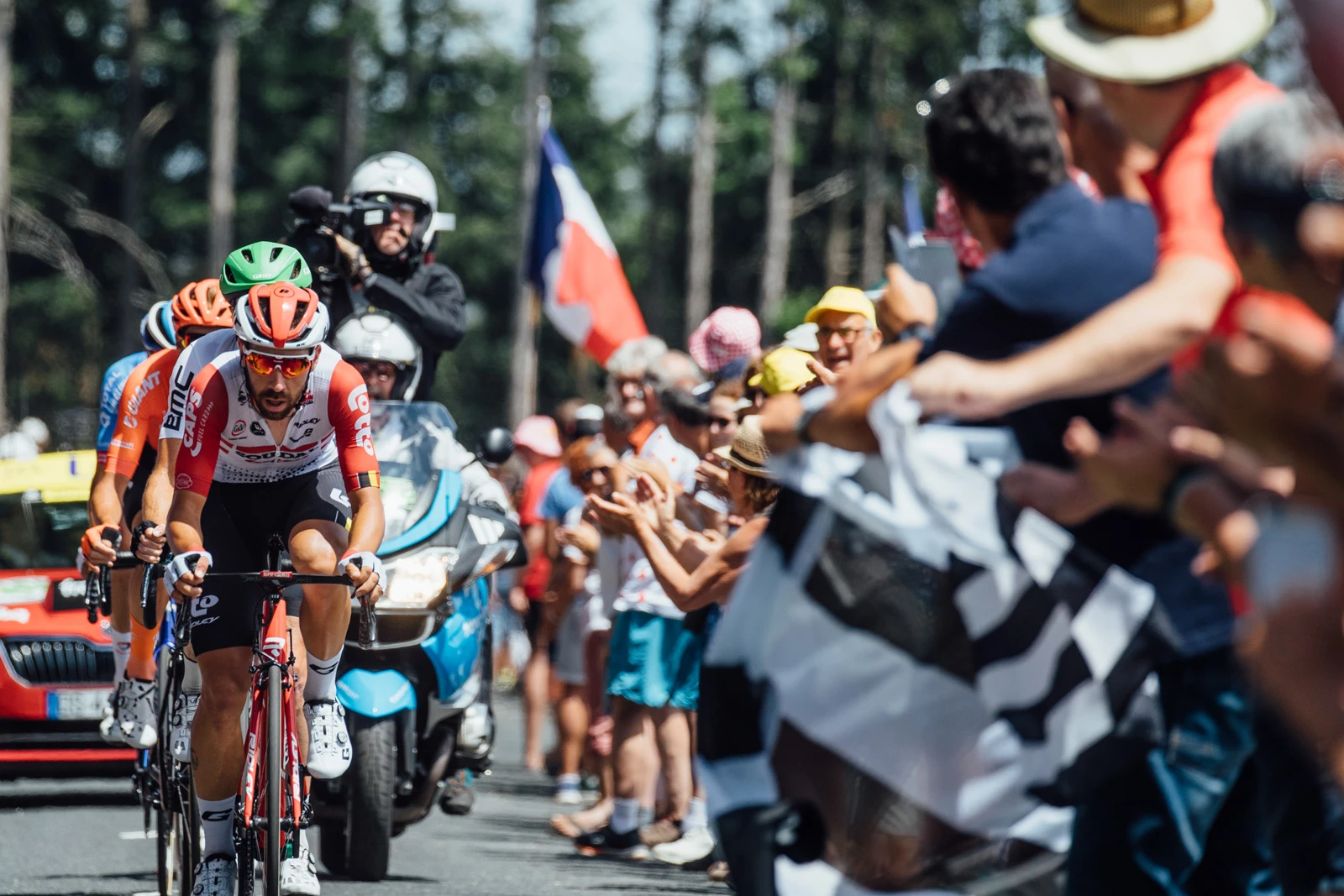
I learn about a group chat between the photographers, discussing locations and where to shoot from. This takes place at the stage start, over an espresso and a croissant. There are a few photographers who know the best spots to shoot from; they talk to the other photographers, but don’t always give away their clues. They know the best areas because they’ve spent time riding it and have been shooting Tour de France for more than ten years. Some other photographers talk about certain locations to shoot from, then decide if that’s best or not. Other photographers plan it all ahead and use Google Maps to pinpoint certain locations. The photographers who I’m with – Chris Auld, Russ Ellis and Zac Williams – tend to chance it and live on the fly. As Chris says, “you’ve got to have a life – there’s got to be some element of fun to it”.
We’re zooming through the course and there’s punters everywhere – after all it is Saturday and it’s the middle of July; Europe is basically on holiday. We scope a location to shoot from and quickly check it without getting out of the vehicle. The photographers dismiss it, saying, “nah, it’s boring and there’s not much going on”, so on we drive to the next spot. I ask how hard is it to shoot a moving race, and Chris replies: “the only difference between us and the regular punter is that we can drive on the course – and that’s it!” Photographers and other media are permitted to drive on the course ahead of, or behind, the race. They cannot, however, join the race convoy, which is what you see on TV; the vehicles following behind the peloton.
The main location for today is a climb, about 50km into the race. It’s hard as we are driving past some amazing locations to shoot from, but it’s a risk to stop. Once you stop, you have to get out of the vehicle, wait for the peloton to ride past, shoot the riders, then hustle back to wherever you’ve managed to park the van. You are then behind the race and need to get back in front of it to get the best shots. This takes negotiating the race route, then heading off the course and joining it again, ahead of the peloton, whilst competitors are still riding at above 40km/h. So, the locations you pick better be good – otherwise it’s a wasted opportunity.
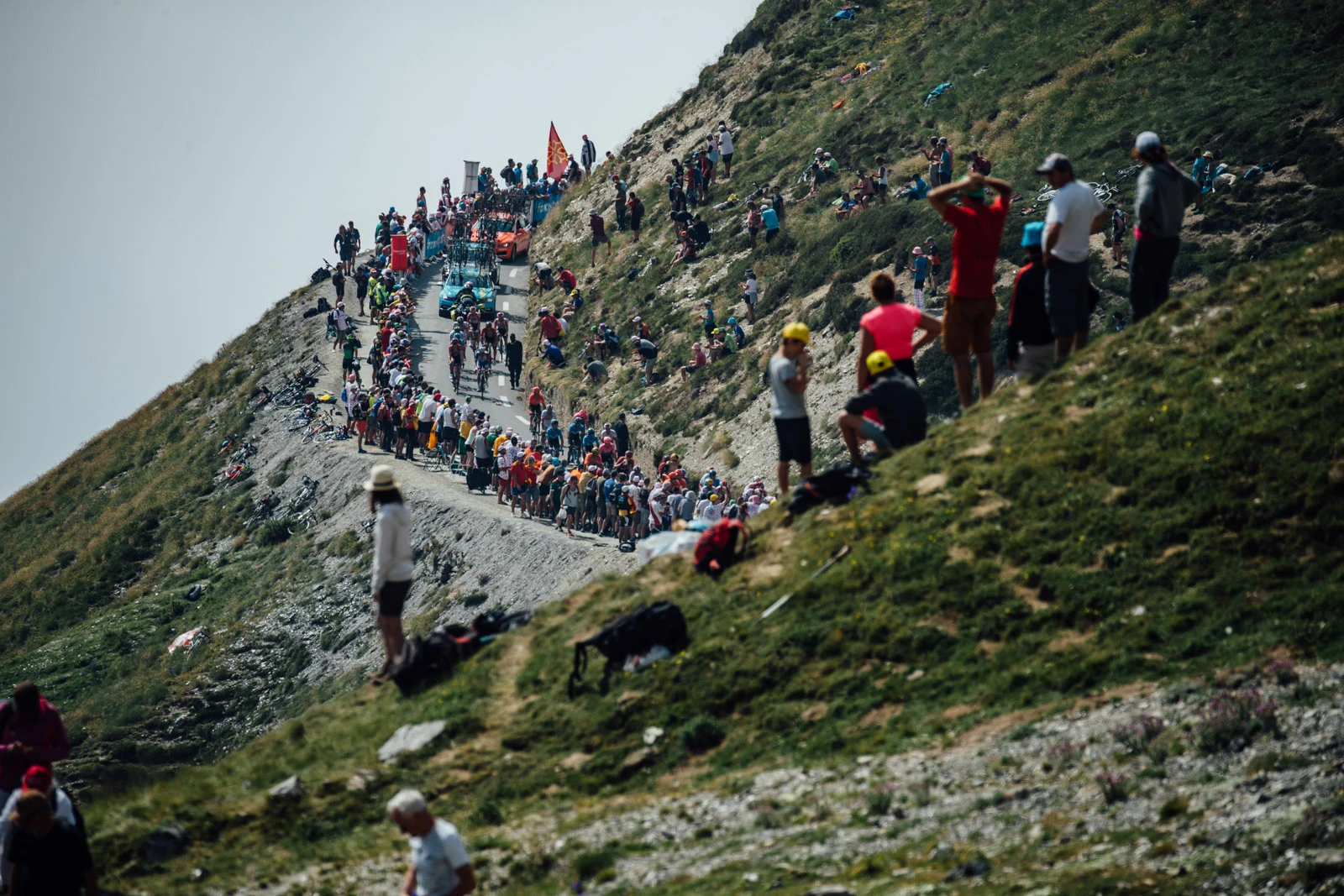
We get to the climb; two of the photographers are scoping it out and the other one is reviewing Google Maps. It’s a tight climb with some steep grades. This is the Beaujolais region, a beautiful valley of vineyards. There are parties are on the hill, and the narrow road means it’s hard to park and get a quick escape route; as a result, there’s literally nowhere to park. The crew tell me it’s not normally like this, and you can usually find a spot to park. Eventually, we find a park on the descent and head back to the climb, scrambling through the bush, trying to find the best spot. The light flickers,coming and going with the clouds, and what with the difficulty finding the right spot, plus the crowding on the road, getting the perfectly timed shot is a challenge. One of Chris’s clients (he’s a photographer for CCC Team) is in the break, which means ‘pay day’ – if he can get the shot. The lead race vehicles go through and he set sets up the shot. Then the break flies past at a rate of knots; punters spread across the road and Chris doesn’t get his guy. We try for another shot of the main peloton.
The next moment, we’re dashing back to van, and taking off at a rapid pace – sans the other two photographers. We drive down the steep descent but can’t find them and we don’t have any cell service. Chris is swearing and there’s mild panic: we can’t go back up the route until the roads reopen, which is still an hour away! We drive on and see Russ, waving his hand, standing on a tight hairpin – he jumps in and we take off with the sliding door still open. On we go and see Zac on another hairpin – he jumps in too and off we race.
The van is driven like a rally car as we speed through tiny villages, over speed bumps and in and out of tight corners. We are route mapping with our phones and the Tour road book. Russ is the co-driver and is on-point with his map-reading skills, juggling two phones and a map book, with his camera still draped over his shoulder. We reach the back of the race convoy and the pace slows – while tensions rise – as we realise we’re behind anofficial race vehicle. The Bora–Hansgrohe soigneur van takes an exit and we think about following but don’t. Instead, we find our exit, wait for the gendarmerie to move the roadblocks, then wind down the window and say, “merci!” before speeding off.
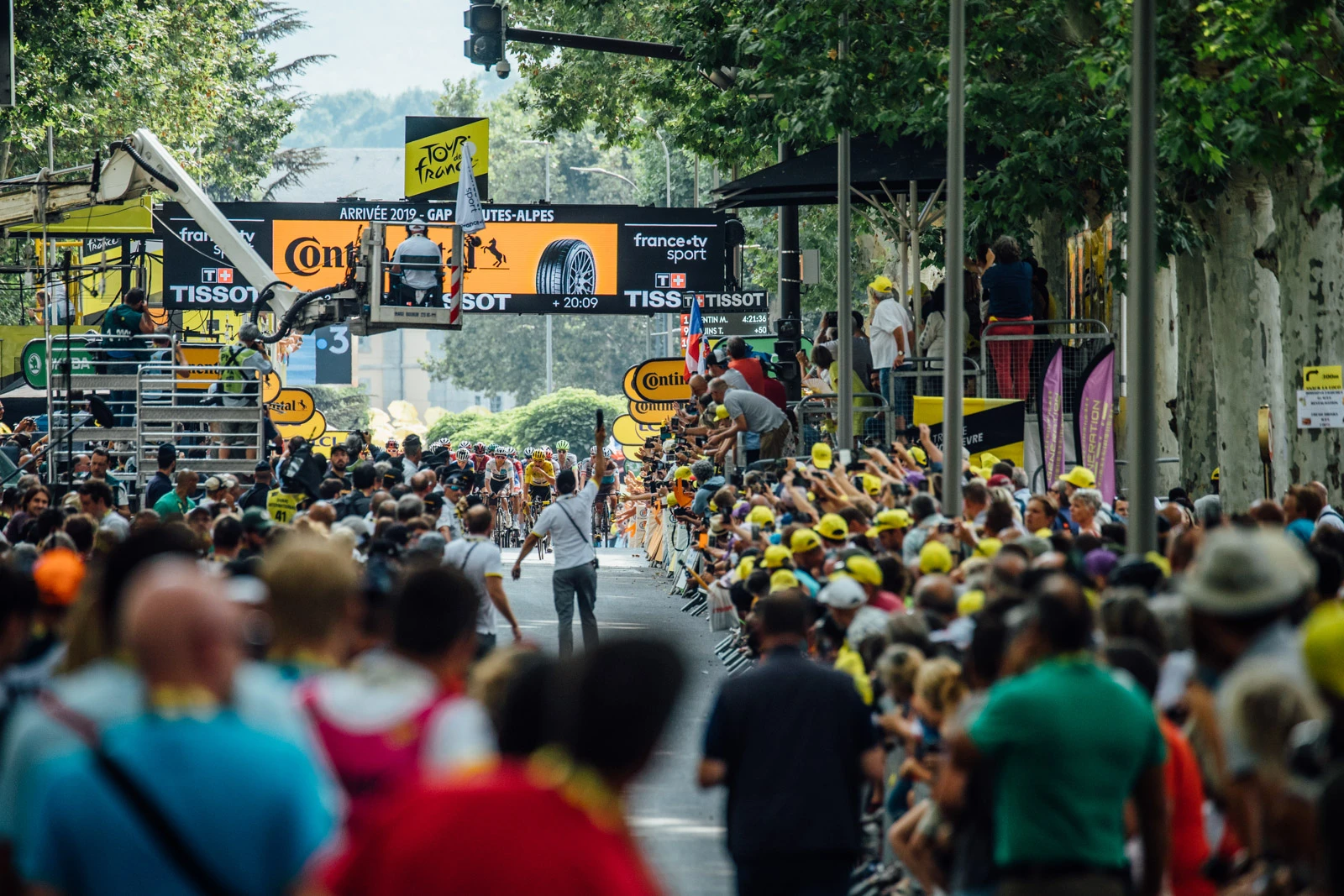
Now we are back on main roads, in a convoy with photography vehicles and Soigneur vans. Russ checks the maps and race times constantly; the race book has the expected times for when riders will be coming through each location. We’re heading to the next major climb and hoping we can make the finish too. There’s nearly two hours between the climb and the finish. It’s a good location to shoot from and we should able to shoot this and the finish – just – but we’d need to hustle and possibly join the race convoy, which is not allowed; the race organisation could take away our permit to drive on the course.
The conversation turns to the next day. Zac is being yelled at by the other photographers to sort it out. This is living on the fly! Zac announces accommodation is now booked – oh, and it’s 50 minutes from the stage start. Russ is deep in digital – and printed – maps, and we’re checking the timings again and again. There’s some looseness to everything, but also a high level of accuracy, and without too much drama we are back on the course. Russ explains; “the risks have to be worth it. Often, I want to shoot landscapes – but you can’t do it all, you need to be realistic about what you can get and the time it takes getting between locations”.
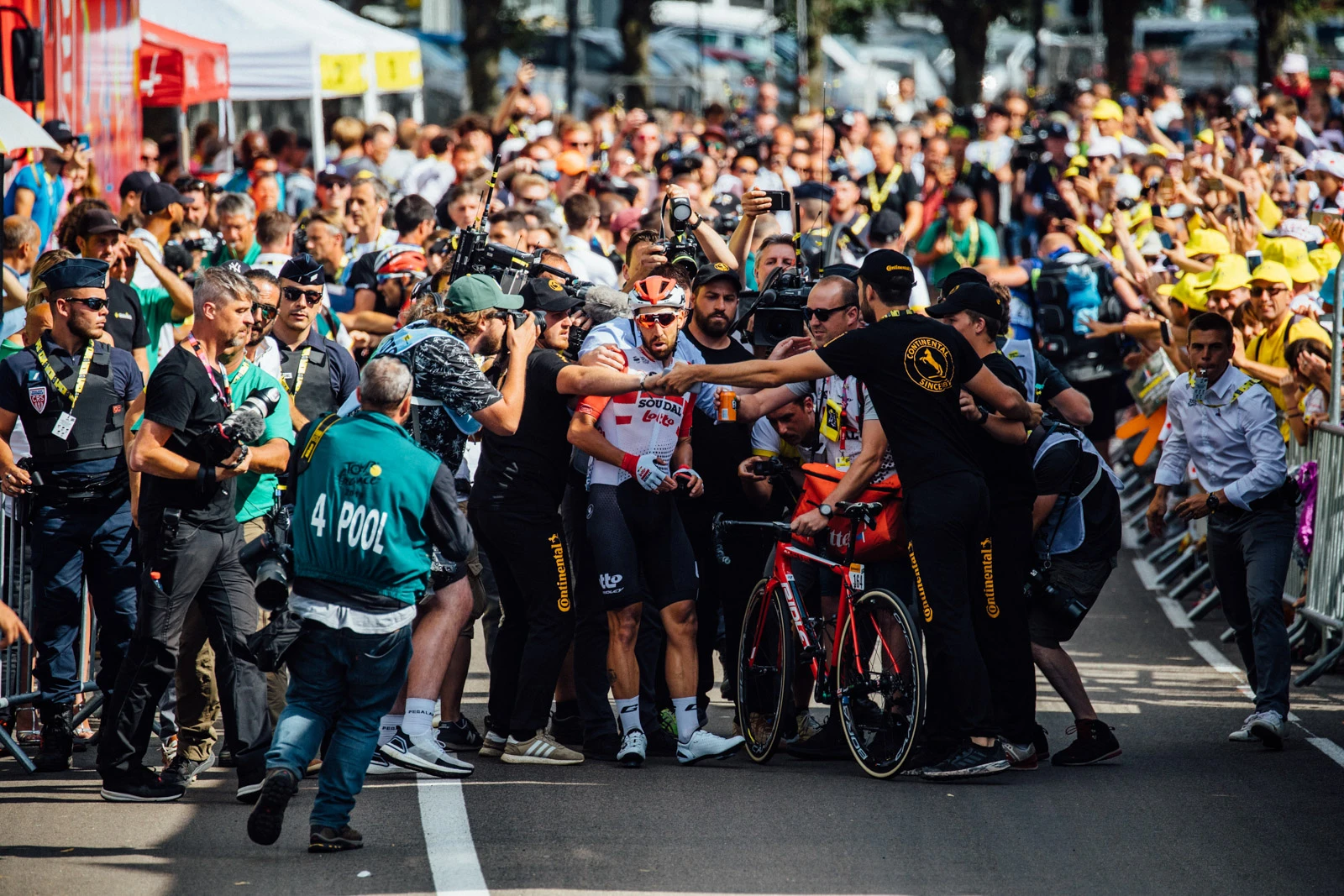
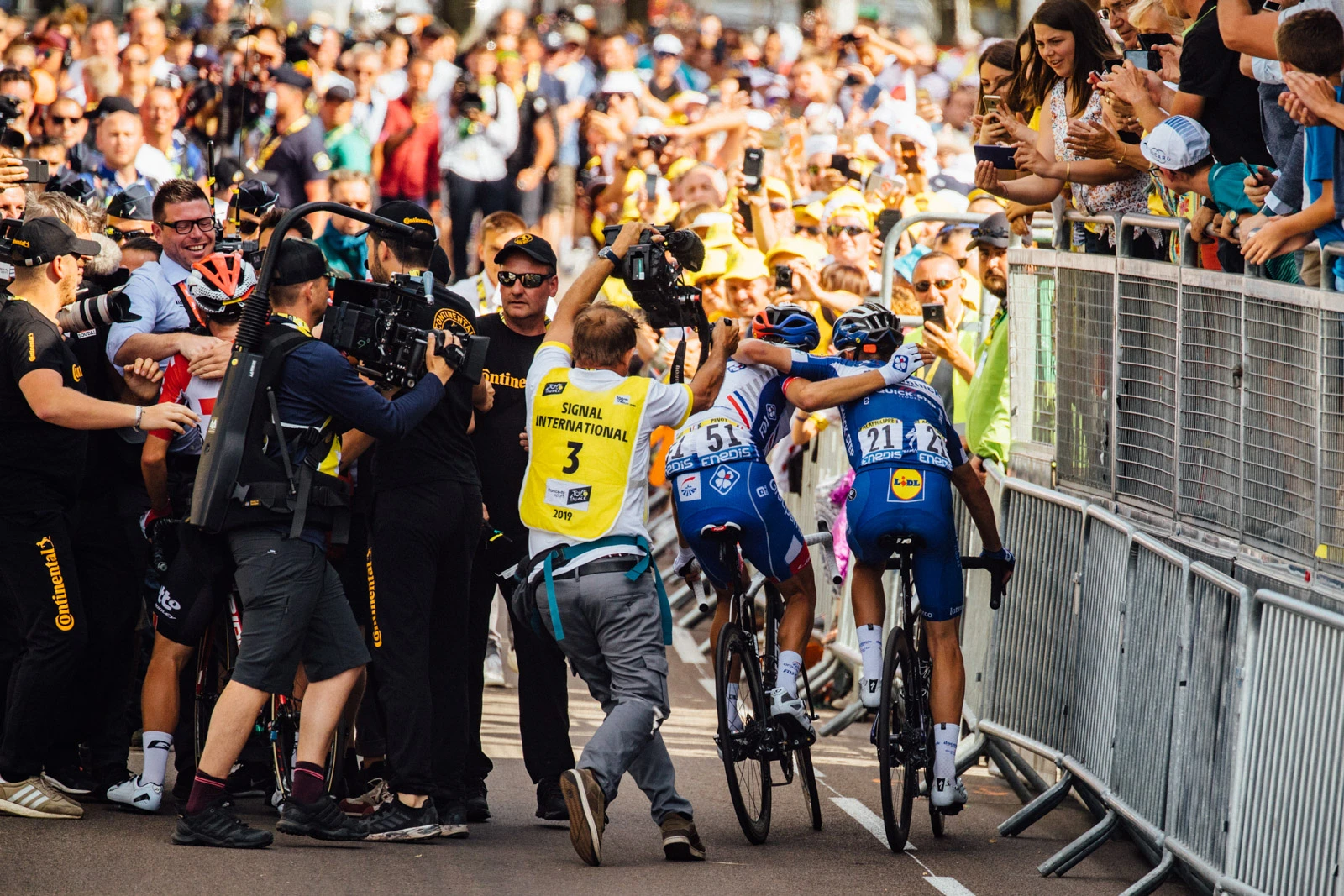

We arrive at the climb location and deliberate: there’s a lot of stress around making the shot and not getting to finish. Russ and Chris have clients that might need finish line shots, especially if one of their teams wins. Russ is shooting for Specialized, and there’s a high chance that Julian Alaphilippe of Deceuninck–Quick-Step could win the stage. We get onto the phones, to find out what’s happening within the race. The gruppetto is about 20minutes back, which means if we join the race we won’t get to finish in time to shoot the leaders. Getting kicked out of the race and not meeting the client’s needs is the big debate – it’s too early to lose our permit. Eventually we get to a small village and there’s not much to shoot against but we have no choice but to take it as there’s nothing between here and the finish. Russ and I walk up and down the main street in search of something to eat – it’s about 3pm and we’ve only had a few snacks – but there’s nothing, not even a boulangerie. We nab a few shots of the break and the peloton, then head off in a mad rush again.
Back on the open roads, one glance at the speedo tells me we’re breaking the speed limit. En route to the finish, we stream the race via a phone. There’s passion for the race, but there’s work to be done – and once again timing is tight. On the open roads we get stuck behind slow drivers, tooting our horn until we can precariously overtake. This happens a few times, but these are people going about their everyday lives – they are not caught up in the Tour de France bubble. The stress of it is pretty intense – a fine balance between managing the traffic on the roads, whilst also being in a real hurry – after all, the race won’t stop!
We finally get to the stage finish – with 15 minutes to spare. The other photographers that we left in the good shooting location have also made it. There’s a little resentment, but that’s the breaks. On this day, Thomas De Gendt of Lotto–Soudal shows remarkable power and manages to sustain the win from the break, and the chase from French hopefuls, Julian Alaphilippe of Deceuninck–Quick-Step and Thibaut Pinot of Groupama–FDJ. In the end, Chris, Russ and Zac get the finish, albeit none of their clients. They head back to the van, grab their laptops and bags, then head to the press room to download the day’s work. For these guys, the day ends around midnight – then they have to do it all again the following morning. The work is endless and relentless – and it’s for three weeks. One thing is for sure: it takes passion and determination to sustain this lifestyle.

